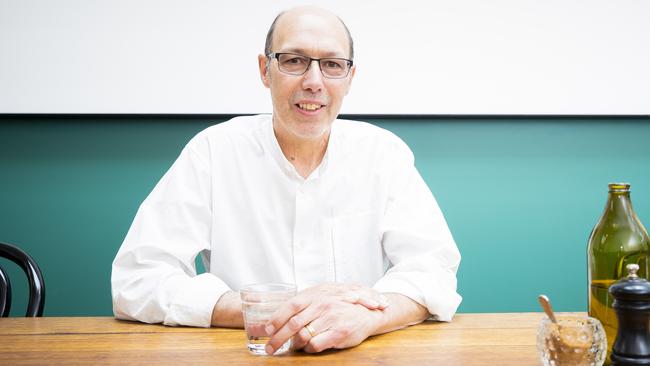Cafe Society: Award-winning designer scathing about CBD street revamp
Bad lighting, wrong trees: Award-winning designer says streetscape revamp in Myer block of Liverpool St is a lesson in what not to do.

Tasmania
Don't miss out on the headlines from Tasmania. Followed categories will be added to My News.
HE wants public art, not monuments to our colonial past. He wants well-designed street furnishings, not generic fittings. He wants green leafy streets, not tarmac and parked cars. And he wants a city centre designed to support vibrant civic life.
When we meet at cafe Berta for our future-focused chat, Jerry de Gryse gets to the point about the Myer block of Liverpool St, Hobart.
“Liverpool St is a missed opportunity,” says the multi-award-winning landscape architect of the recent streetscape revamp.
“Our city spent a lot of time and money to try to lift the standard and in so many ways it has missed the mark.”
Jerry points to the tulip trees (Liriodendron tulipifera) as part of the problem. Given his firm, Inspiring Place, helped write the City of Hobart’s Street Tree Strategy published two years ago, I am all ears. “The trees out there are lollipops,” he says. “They are planted in an inadequate volume of soil, which will not support a tree of any longevity or any size ... They are beautiful trees, but they need soil to survive.”
As well, he says that as a fastigiate not spreading variety, they are the wrong type of tulip tree to create an appealing overarching canopy of dappled light.
Speaking of light, Jerry joins two of my previous column guests, Dark Mofo creative director Leigh Carmichael and Dark Sky Tasmania’s Landon Bannister, in his dismay over the artificial illumination of this block.
“Despite people trying to do things differently we have ended up with this grossly overlit street. It is light pollution.”
Though he finds much to love around Hobart, Jerry says the beauty of our built environment falls far short of the beauty of our natural surrounds.
“Hobart’s Instagrammable tourism imagery is reliant on what is left of the place Europeans inherited from the original inhabitants — a mosaic of vegetated hill slopes, rugged topography, undulating foreshore and the deep space looking inland to the wild and outward to the ocean,” he says.
To bring up the lagging flank, he thinks we need to focus more on the idea of “liveability infrastructure” — natural and cultural assets including lighting, green spaces and street trees, seating, pedestrian and cycling networks and public art.
He wants Elizabeth St to become a pedestrian zone from Federal St, North Hobart, to the waterfront, with wider footpaths, an electric tram, and few or no cars.
Jerry proposed a tramline on the route in the 1989 North Hobart Townscapes Strategy and says the idea remains viable. Then, as now, it is hardly radical — Hobart having once boasted an extensive tram network. He says good public transport would serve locals and tourists.
“The cable car in San Francisco is a classic example where the tourists are underwriting the cost of the guy and woman in business suits going to work.”
When I ask Jerry what he thinks of a proposed cable car for kunanyi/Mt Wellington, I am yet to learn that only one of four award-winning projects his firm was recognised for this year resulted in a direct build — the Lily Pads viewing platform at the Royal Tasmanian Botanical Gardens.
As he says, monuments are not his thing, but a sensitive interpretative response to surroundings is. And that’s why he reckons we should let the mountain be.
“I am adamantly opposed to a cable car,” he says. “I think the proponents underplay the visual impact of what will actually be a function centre accessed by a cable bus.
“I’ve taken cable cars elsewhere in the world and my experience was that I got to the top and all I could smell was fish and chips. The mountain is emblematic of our city and to privatise that, to commercialise it, takes away from its intrinsic value as a natural element.”
His big picture? “I want us to do things better and do them whole,” he says. “I want Hobart to continue to build on the momentum of recent years. There’s a little bit more money around to do things.
“And let’s do things whole. In our profession, we do a lot of masterplans and only 10 per cent of it gets done, and 10 years later someone calls for another masterplan.”
MORE CAFE SOCIETY:
ADAM MARTIN: TEACHING MEN TO LEARN FROM WOMEN
CURLY HASLAM-COATES: SOW THE CREATIVE SEEDS EARLY
MARK DAVIS: MORE HELP TO FEND OFF THE BLACK DOG


